The MATTER Lab (Mind-Assisting Technologies for Therapy, Education, and Research) has a mission to advance our understanding and care of mental health by building, improving, and deploying technologies for use in therapy, education, and research.
Applied Technologies
Technology Transfer Hub
Our portfolio of technologies designed to help struggling children.
Forms and Policies
- Policy on Intellectual Property
- Conflict of Interest and Disclosure Policy
- Policy on Financial Conflicts of Interest for PHS-funded Projects
- Policy on Indirect and Administrative Costs
DHHS-Negotiated Facilities & Administrative (F&A) Costs Rate
On-Site
- 10/1/2020 – 9/30/2021 40.3% (Final)
- 10/1/2021 – 9/30/2024 40.3% (Provisional)
Base
Total direct costs excluding capital expenditures (building, individual items of equipment; alterations and renovations), and that portion of each subaward in excess of $25,000.
Fringe Benefits Rate
- Effective 10/1/2022 – 12/31/2023
- Executive 18.7%
- Management 23.7%
- Staff 31.9%
- Clinicians 25.6%
Our Technology Portfolio
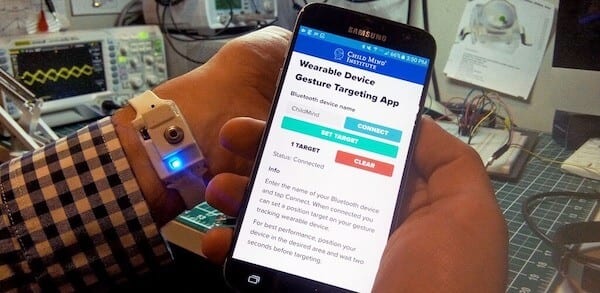
Status and Patent. We have created a prototype for a wrist-worn device that can monitor and record gestures and motions such as face-touching and body-focused repetitive behaviors (BFRBs) while also providing real-time (haptic) feedback (on the wrist) to the individual to help stop these behaviors. The device is the subject of U.S. Patent Nos. 10,119,807 and 10,520,297.
Description and Usage. This device can monitor face touching and BFRBs, including pulling out hair, skin picking, as well less severe but damaging behaviors such as nail biting, thumb sucking, and nose picking. Immediate, real-time feedback can help people stop touching their face, which has the potential to save lives in situations such as the current pandemic, and to help people reduce BFRBs.
Results and Future. The performance characteristics in healthy volunteers were studied and published (Son JJ et al., “Thermal Sensors Improve Wrist-Worn Position Tracking,” Nature Digital Medicine (2019) 2:15). We are preparing to conduct additional trials to demonstrate the device’s effectiveness at reducing face-touching. The device is currently a prototype, but designed for manufacturing. We are currently seeking opportunities to commercialize for widespread use.
![]()
Status and Patent. Our position tracking wearable prototype is the subject of U.S. Patent Nos. 10,119,807 and 10,520,297.
Description and Usage. The position tracking wearable device uses thermal sensors to track its position relative to the body. This innovative standalone approach to position tracking without cameras has the potential to increase the accuracy of measuring movement in real time. The device is also lightweight, non-intrusive and self-contained, making it ideal for integrating into augmented or virtual reality systems. See the description of our gesture recognition wearable device, which also serves to track position of the hand with respect to the head and torso, but more specifically for monitoring and feedback to reduce face touching and body-focused repetitive behaviors.
Results and Future. This wearable device is currently a prototype. We are currently seeking opportunities to commercialize for widespread use in position tracking for console game playing, VR, AR, etc.
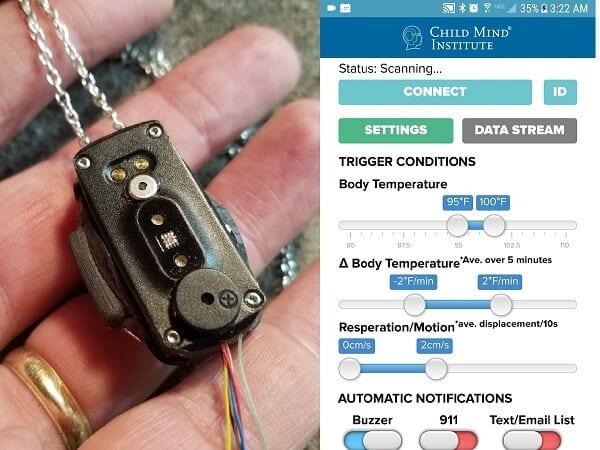
Status and Patent. Our drug overdose detector is a prototype for a wearable device.
Description and Usage. This device is the first in a series of projects exploring wearable device solutions to drug overdose and drug addiction.The primary motivation for building this prototype was to start a discussion with the National Institute on Drug Abuse on potential opportunities to detect opiate overdose with inexpensive devices built from off-the-shelf components. Depressed respiration is the best way to detect opiate overdose and the only approved indicator for the administration of Narcan (Naloxone). The device contains an accelerometer, a PPG optical heart rate sensor and a thermopile contactless thermometer to detect skin temperature. The device also contains an extremely loud buzzer and is connected to a smartphone app which is designed to alert an emergency response team (this feature is currently a proof-of-concept). The general idea is that the device uses sensor data to detect a possible drug overdose event. The device then activates its buzzer. If the user does not deactivate the buzzer after an allotted period of time it is assumed that an overdose is taking place and the device alerts emergency responders through the connected phone app.
Results and Future. We are working on similar, more practical devices and welcome opportunities for collaboration on this project.
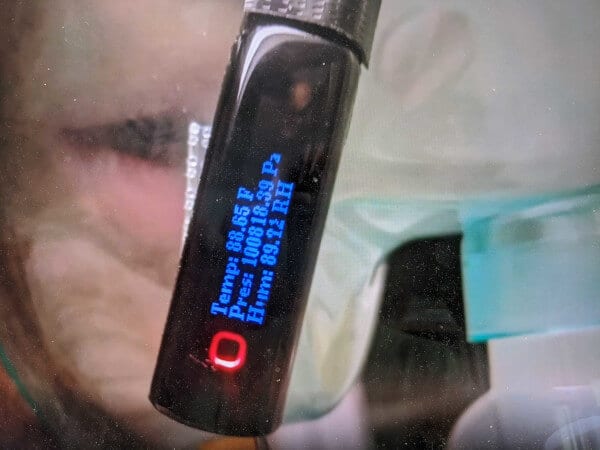
Status and Patent. Our respirometer is the subject of subject of pending U.S. Patent Application No. 16/816,220.
Description and Usage. The device’s primary intended use is respiratory rate vital sign monitoring, although many other uses are possible. The device functions by gathering and analyzing time series data from a number of sensors, namely surface temperature (thermopile), air temperature, air pressure and air water content (humidity). The efficacy of the device is dependent on the presence of an exhalation vent in an oxygen mask, something that is universal to oxygen masks. The device sensors are placed directly over the vent, in a fashion that very clearly does not risk blocking the vent.
Results and Future. The device is capable of independently computing respiration rate from time series sensor data. Currently, this is accomplished with peak detection and relatively simple filtering, but this sort of data processing can be done many different ways. The device contains a Bluetooth radio, and can transmit raw sensor data to a computer or mobile device. Raw sensor data from the device could be incorporated into computer software to provide a great deal more information than simple respiration rate. Respiration strength, volume, acceleration and any abnormalities thereof can be computed. The device is attached to the oxygen mask with an adhesive-backed reclosable fastener (like velcro). In order to accommodate a variety of oxygen mask shapes, the sensors themselves are placed in an adjustable hinged arm attached to the main device body. Design of the device for placement inside the mask is possible, if integrated into the oxygen mask itself.
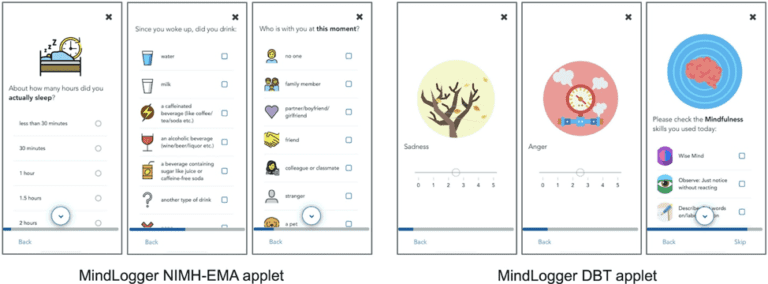
Status and Patent. MindLogger is an open source product.
Description and Usage. The MATTER Lab is developing MindLogger to make it easy for anyone to build activities to present, collect, and analyze information using mobile devices. Example activities include surveys, quizzes, digital diaries, cognitive tasks, and interventions. The three key innovations are: customizability of content, response options, and appearance; an extensive library of activities built using open standards (open, reusable parts defined by an open protocol); and distribution as a single app that appears differently to different user groups. This tool is more relevant than ever as healthcare evolves to incorporate more telehealth and remote options.
Results and Future. MindLogger is currently being used to gather survey data as part of the 10,000-person Healthy Brain Network research study. After this initial test, MindLogger will be used in research studies by our collaborators at the National Institute of Mental Health, MIT, the Université de Paris (CRI), ETH and Citizen Science Centre in Zurich, and elsewhere.
Status and Patent. CrisisLogger is an open source product.
Description and Usage. Developed in partnership with researchers at the National Institute of Mental Health, CRI Université de Paris, the Massachusetts Institute of Technology, and OpenHumans.org, CrisisLogger wants to hear about the emotions that people are experiencing during the COVID-19 Crisis. Through this online platform, users can share their struggles, fears, frustrations, hopes, and more — publicly or privately — through audio, video, or text messages. These messages are then converted into word clouds to capture the theme. Participants can decide whether or not they want to contribute their submissions for scientific research or keep them private. CrisisLogger also allows users to view the public submissions of others, which could help to offer support through shared experiences.
Results and Future. CrisisLogger is currently collecting data. We have recently added the capability to customize the site for different data collection efforts (different landing page content, different questionnaire) by simply adding a new subdomain (e.g., climate.crisislogger.org) and folder of alternate content.
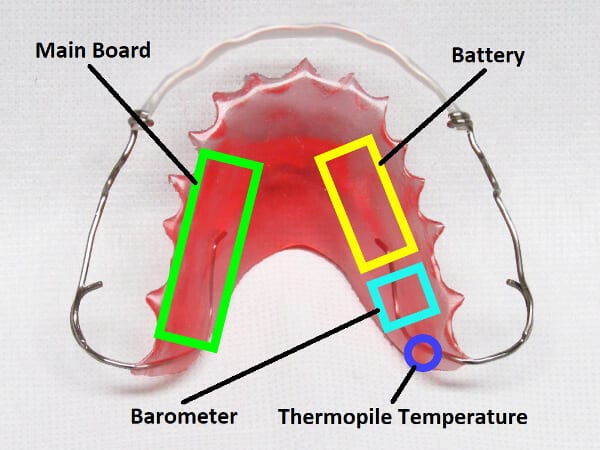
Status and Patent. The monitor is a prototype and we are seeking patent protection. We are working on similar devices with broader consumer applications. Our monitor is the subject of U.S. Patent No. 10,758,156.
Description and Usage. This device measures the air pressure, humidity and skin temperature inside the user’s airway. It consists of a BME280 air pressure sensor + MLX90615 thermopile thermometer + miniature nRF51822-based activity tracker mounted on an ultra-thin custom dental retainer, and contains a 16Mhz ARM Cortex M0 microprocessor combined with a Bluetooth radio for wireless communication (Nordic nRF51822). We stream data to a Web Bluetooth-enabled web application. The streamed data is displayed graphically but can also be used to train and then apply data to a LSTM MLP neural network for the purpose of tracking respiration. The BME280 air pressure sensor is extremely sensitive and can acquire the respiration waveform regardless of whether users breathe through nose or mouth. The primary motivation for building this prototype was to start a discussion with the National Institute on Drug Abuse on potential opportunities to detect opiate overdose with a future, miniaturized version of such a device, or other form factor and placement. Depressed respiration is the best way to detect opiate overdose and the only approved indicator for the administration of Narcan (Naloxone). Full waveform respiration data is surprisingly difficult to obtain. Spirometers, chest-straps and pulse oximetry (including photoplethysmography) are relatively inaccurate – particularly when respiration becomes depressed.
Results and Future. We are seeking opportunities to commercialize for widespread use.
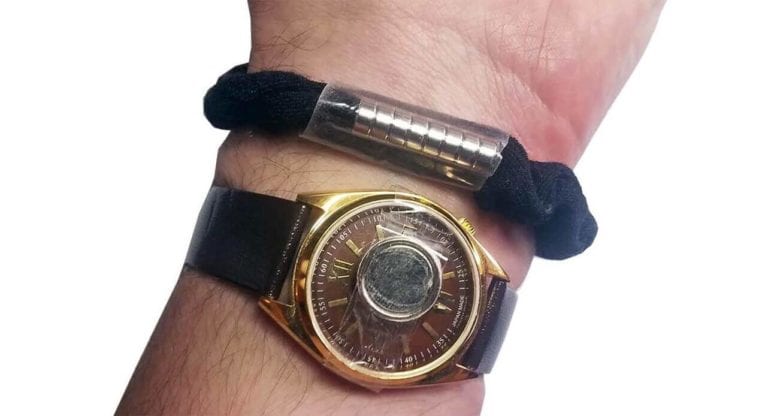
Status and Patent. “Face Guardian” is entirely open source. Development is ongoing and contributions are welcome.
Description and Usage. You use a phone’s compass and a magnet on your wrist to detect face touching, including audio and vibration alerts. Face touching is one of the primary ways people contract SARS-CoV-2, the coronavirus responsible for COVID-19. People on average touch their faces 23 times an hour. It is a deeply ingrained unconscious behavior. Face Guardian is an attempt to solve this problem in a highly scalable fashion. All it requires is a smartphone and a magnet. Face Guardian’s target demographic is parents and children stuck at home during the coronavirus pandemic. Although this is meant to be a fun educational activity for parents and children, anyone can benefit from it.
Results and Future. You can get the Android app on Google Play or go to the mobile web app by visiting the project on matter.childmind.org. The primary focus of the MATTER Labs efforts is the Gesture Recognition Device.
